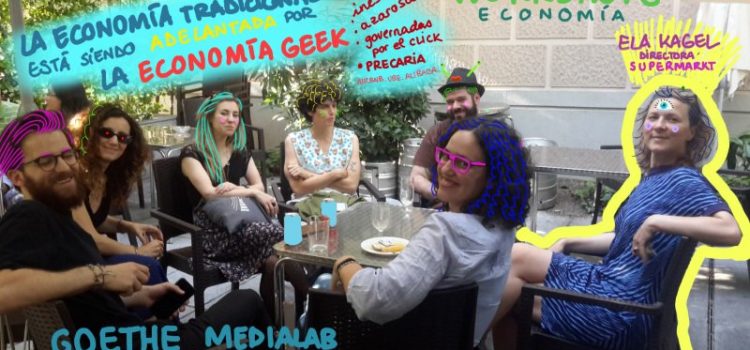This is the documentation of our workshop “Culture as Commons – from the Creative Industries to Collaborative Economies” from May 24.-26., 2017 in Madrid. Hosted by the Goethe Institut Madrid and Medialab Prado, this workshop was part of the larger conference & workshop series #Kulturkabinett. Together with a group of inspiring cultural producers & cultural managers from Madrid and Barcelona we engaged in an intense, two-days workshop with the aim of understanding better the outline of an economy of and for culture.
We started off by creating a micro-economy between our group. Everyone was enouraged to look at each other as a potential resource and to capture everything one wants to offer and also the things one is looking for in exchange. That’s how a basic economic system works – a small market that is immediately accessible, where people start to barter for goods and seek their own value system when it comes to exchanging knowledge, contacts or physical things.
From the notion of micro-economies, we moved on to mapping out certain characteristics of both culture and economy. This worked well for a while, until we realized that apparently we still had quite a traditional image of the “the economy” in our minds: the good old days, when mainly things were produced in pipeline-structured production processes, then disseminated in many different channels. An economy that had to provide regulated work hours, workers rights and so forth. In today’s gig economy, jobs are random, precarious and based on independent contracts – which endangers many of the workers’ rights achievements both unions & individuals have been fighting for over centuries.
After having realised that the gig economy has a lot in common with cultural work (precariousness, uncertaintity of values & pricing temporality, individualism..), we noticed that these new economic phenomenas are part of a larger shift in cultural & social environments. In order to understand that better, we also needed to look into the notions of the sharing economy, the collaborative economy or the platform economy.
We continued with a mapping exercise, in which we tried to map out the cultural landscape in which we live in. Little territories of “subsidized culture” or “independent culture” or “cultural heritage” are floating on a sea which I would like to label as the “common cultural realm”. This sphere is defined by the sum of our social actions in a collective society and characterises also the ways of communication, exchange, language(s), stories and many other intangible factors that tie socities together. We figured that this common cultural realm can only function properly if we have an agreement on the use of public space and an agreement of what makes a common good.
This then brought us into the history of the commons and our collective rights to the natural commons. We also looked into the work of Cornelia Sollfrank or Ruth Catlow, who both do extensive research in the field of arts and commons.
Starting from there, we broadened our view into the commons by learning from the works of Vandana Shiva or Elinor Ostrom, who provides us with a set of rules of how to manage a common good.
On the second workshop day, we started to ask ourselves: why are cultural organisations often so dysfunctional when it comes to providing stability, financial security and wellbeing for their members? What are the reasons here? To what extend have cultural managers already internalised the meme that working in arts & culture equals scarcity inevitably? We collected all the reasons in a list, which I found most insightful. Please find photos of the complete list in the embedded presentation below.
We also touched down on the question why the traditional business plan is not enough to plan and maintain a cultural project. Having said that we together invented a complimentary metrics to the business model canvas, which we called the “set of internal values”. Internal values reflect the social relations, the group motivation and the overall communication culture, as well as the desired achievements with regards to the community, biodiversity, social justice, environmental protection, education and so forth. It is only with this holistic viewpoint, we found, that we can engage in a profound projection of current and future values.
As a final exercise, we mapped out the business and value-criteria of our own projects. With all the work we invested before that, this proved to be the most valuable exercise. However, this was private and is therefore not included in the reader which we collaboratively put together to document our shared research during these two workshop days in Madrid.
Enjoy the presentation!
Blogpost image courtesy of Goethe Institut. This presentation was co-authored by Ana Javierre, Ariadne Rodriguez, Arantza Martínez Eguia, Bryan Amat, Eva Abad, Ela Kagel, Jorge San Vicente, Pedro Toro

